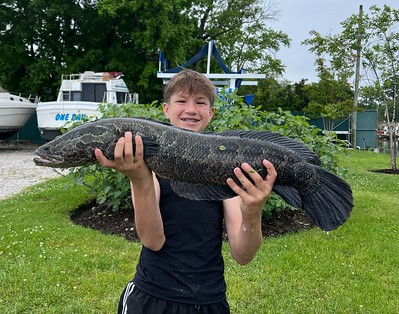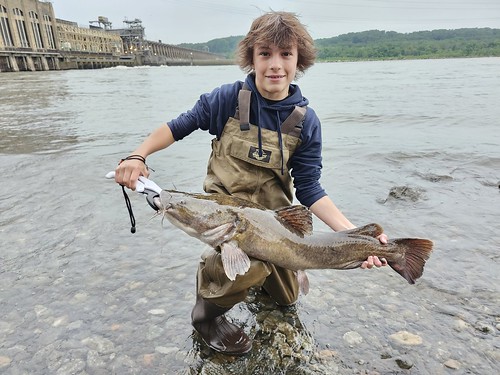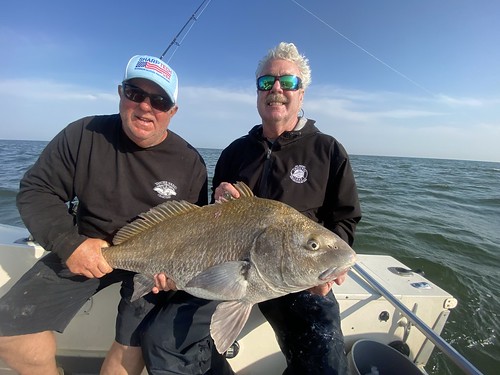
Matt Ferenschak has a good reason to smile with this whopper of a Chesapeake channa (snakehead) that he caught in the Middle River. Photo courtesy of Matt Ferenschak
With Memorial Day weekend, the traditional beginning of the summer season is upon us. Remember to take a moment to reflect on those who made the ultimate sacrifice for our freedoms, including the ability to enjoy the outdoors with families and friends.
Striped bass season opened with a couple good days until some wind and rain put a damper on weekend fishing. With the return of fair weather, anglers are enjoying a chance to land Maryland’s state fish.
The Maryland Department of Natural Resources urges everyone to familiarize themselves with the 2024 striped bass regulations. The DNR website also has a map site link that shows the areas of the Chesapeake Bay where anglers can fish for striped bass as the season progresses. And you can keep up with the latest news and information about striped bass in Maryland.
Maryland offers license-free fishing days for all state residents and visitors on June 1, June 8, and July 4. These annual events provide anyone a unique opportunity to explore the state’s diverse fishing without needing a fishing license, trout stamp, or registration. It’s a great opportunity for anglers to introduce someone to fishing.
Forecast Summary: May 15 – May 21:
Warm but wet weather this week will make for unstable fishing conditions in Maryland’s waters. Main Bay surface water temperatures have warmed to about 70 degrees. River temperatures have also risen to the mid to upper 60s. On the Potomac River, avoid the low oxygen areas below 15 feet between the Wicomico River and St. Georges Island. With Maryland’s part of the Bay running fresher than average, there will be abundant areas with suitable salinity for hunting blue catfish. There are plenty of cool, oxygenated waters in the lower portion of the tidal rivers as well as the Bay for searching out striped bass. As always, the best fishing areas could be further refined by intersecting them with underwater points, hard bottom, drop-offs, and large schools of baitfish.
Expect average flows for most of Maryland rivers and streams. Expect average water clarity for the Maryland portion of the Bay. To see the latest water clarity conditions, check Eyes on the Bay satellite maps. There will be above average tidal currents all week as a result of the full moon on May 23.
For more detailed and up-to-date fishing conditions in your area, continue to check out Click Before You Cast.
Upper Chesapeake Bay

Lucca Tucciarella caught this nice flathead catfish in the dam pool recently. Photo by Vincent Tucciarella
Anglers are seeing the last of the hickory shad in the lower Susquehanna River and Octararo Creek this week, and the numbers of American shad are also dwindling. There are exciting numbers of Chesapeake channa (snakehead) being caught near the Conowingo Dam pool on white paddletails and spinnerbaits. Large smallmouth bass are also entertaining anglers casting a variety of crankbaits, soft plastic jigs, and tubes. Flathead catfish are in the dam pool and being caught on cut bait.
A little farther down the Susquehanna River white perch are being caught in about 15 feet to 20 feet of water. At times it takes a little searching but when found, good fishing prevails. Dropper rigs containing two small flies or small shad darts work well, as do small minnows on a bottom rig. Anglers should take note that a dropper rig can contain no more than two hooks or lures in Maryland waters, so a sinker is used to get the rig down to where the perch are. If the current allows, working small spinnerbaits and shad darts are a fun way to fish for white perch.
Anglers were out in force this past week for the first segment of the 2024 striped bass season. Many were trolling along channel edges at familiar locations, but others found good action by jigging near favored locations such as the Love Point Rocks. There was good jigging action at the Bay Bridge piers while another group chummed and chunked there. An enterprising group even brought with them spot from the middle Bay for live-lining.
Anglers who were chumming or chunking also attracted blue catfish, which are usually large, and helped add some meat to fish coolers. Fishing for large blue catfish in the upper Bay continues to be epic due to low salinity values. Salinity values in the upper Bay are averaging 2 ppt or less, and water temperatures are holding in the mid-60s. There are plenty of blue catfish in the tidal rivers and often tend to be a little smaller than those out in the Bay. The tidal rivers offer many places to fish from shore and the upper Bay is also dotted with many access points to good fishing. Sandy Point State Park is a great place to fish off the rock jetty by the Bay Bridge.
White perch are providing good fishing this week in the lower sections of the region’s tidal rivers and creeks. In many areas they are now residing in their typical summer habitats and providing fun fishing opportunities at familiar locations. In the morning and evening, casting small spinnerbaits, spinners and soft plastic swimbaits or jigs is a fun light tackle way to fish. Dropping a simple bottom rig baited with grass shrimp or pieces of bloodworm close to old dock pilings or oyster beds is a tried-and-true way to fish for white perch.
Middle Bay
Striped bass anglers were ready to go for the May 16 opening of the 2024 striped bass season and most were not disappointed. A portion of the anglers took to trolling umbrella rigs and tandem rigged swimshads and bucktails along favorite channel edges, The 25-foot to 30-foot channel edge outside Hacketts Bar south to Tolly Bar got a lot of action on opening day, as did the channel edge south of Buoy 83 and off Chesapeake Beach and Breezy Point.
It seemed that most of the success came to those casting a variety of soft plastic jigs and paddletails along shoreline structure. The rock wall at Poplar Island, the waters in front of the Naval Academy, and Thomas Point are just a few of the locations where anglers found good success in relatively shallow waters.
Spot have been in the lower Bay for a week or so and they started showing up at traditional locations this past week. Anglers took advantage of the resource and began using the spot for live-lining with excellent success. Anglers must use non-offset circle hooks when targeting striped bass when live-lining.

Cooper Teal was fishing in the Rhoade River when he caught this large blue catfish. Photo courtesy of Cooper Teal
Some anglers casting paddletails and soft plastic jigs in the middle Bay received a welcomed surprise with the season’s first speckled trout and puppy drum. The shallows around the mouth of the little Choptank and the Taylors Island shoreline were good places to fish during the morning and evening hours when the tide was running. The mouth of the Choptank River is open to striped bass fishing in an area from Holland Point to a point of land at the west entrance of Chapel Creek. After June 1, all the waters of the Choptank River will be open to striped bass fishing.
Some anglers chose to go fishing in the region’s tidal rivers for blue catfish this week. The Choptank River from the Denton area south to Cambridge is providing good fishing for the blue cat. Fresh cut menhaden has been the most popular bait being used on a fish finder rig with a circle hook.
Lower Bay
There is a lot of exciting fishing action in the lower Bay this week. The first segment of the 2024 striped bass season opened and other exciting fish were caught as well. Anglers who are casting to their favorite shallow water shoreline locations are finding excellent striped bass fishing but are also finding speckled trout and puppy drum in the mix. The Tangier and Pocomoke sounds are currently providing the best action for the three species. Casting paddletails and spooks over grass beds seems to be the front row ticket to this action. Speckled trout and puppy drum as well as striped bass are also being caught in the lower Potomac River near Point Lookout. Other favorite spots are the Cedar Point rocks, lower Patuxent River shorelines, and the Hoopers Island cuts – a great place for “walking the dog,” which is to cast soft plastic jigs and work them along the bottom as the current sweeps them past.
There are plenty of spot to be found in the lower Patuxent area, and striped bass anglers are wasting no time collecting a bunch and heading to favorite channel edges for live-lining. The 30-foot edge in front of Cove Point is always a favorite spot to check, as is the steep channel edge from St. Georges Island to Piney Point in the lower Potomac River. The Point-No-Point area is another location to check with a depth finder to locate suspended striped bass.

Dale Withers holds up a nice black drum for a photo before releasing it. Photo courtesy of Dale Withers
Large red drum have moved into the region and are mostly being found from the Middle Grounds up past the Target Ship. Some anglers are targeting them by jigging, and others are trolling large spoons. Large black drum are also in the same area and are mostly being caught on soft crab baits when they can be located on a depth finder.
Blue catfish are always ready and willing to entertain lower bay anglers and provide plenty of meat to fill ice chests. The tidal Potomac River from the Wilson Bridge to the mouth of the river is full of them, and they will likely stay in the lowest part of the river as long as salinity values are low from repeated rain events. The tidal Patuxent River from Jug Bay south offers excellent blue catfish fishing as does the Nanticoke River near Sharptown and south. The Wicomico and Pocomoke are seeing increasing numbers of blue catfish.
White perch are providing plenty of fun fishing this week in the lower sections of the region’s tidal rivers as well as Tangier and Pocomoke sounds. In shallower waters casting small spinnerbaits, spinners, and small soft plastic swimbaits is a fun way to catch them in the morning and evening hours along the shorelines. In deeper waters bottom rigs baited with pieces of bloodworm is the most common way to catch them.
Recreational crabbers are checking out some of their favorite spots this week and more than a few feel the pressure to provide crabs for Memorial Day weekend. Reports tell of medium-sized crabs coming from waters around 15 feet deep or so, and small crabs in the shallower waters. Although most legal crabs being caught only measure around 5.5 inches, they are heavy and have not shed yet. The lower Eastern Shore tidal rivers are providing the best catches, but middle river waters are producing also. One recreational crabber relayed a funny story of a 15-to-20-pound blue catfish that took a whole trotline clam bag inside his mouth and almost came into the boat, but the crab net was too small, and he wiggled free.
Freshwater Fishing
Trout fishing is drifting away from many anglers’ thoughts as the month of May nears an end. There are still plenty of trout out there, it just takes a little searching since they are spread out. One of the best ways to cover a lot of water is by casting small spinners, flashy spoons. and tiny jerkbaits with spinning gear.
The Maryland Department of Natural Resources has completed the 2024 spring trout stocking season, placing 219,000 rainbow, golden rainbow, and brown trout in 119 waterbodies from December to May. Overall, brown trout averaged about a half pound each with rainbows and golden rainbows slightly larger. In addition, 325 trophy-sized trout from the Albert Powell Hatchery and another 270 from the Bear Creek Hatchery weighing four to ten pounds each were mixed in the loads for added excitement. Trout for the spring season were reared at the Bear Creek, Albert Powell, Unicorn, and Joseph Manning Hatcheries. DNR is also asking anyone who participated in our inaugural youth trout fishing day back in March to share your comments in our online survey.
Cool mountain streams and rivers of western Maryland hold excellent catch and release trout fishing all summer long for those who can match the various hatches of aquatic insects or terrestrial insects that happen to fall into the water. There are also some delayed harvest waters that have been catch-and-release but will open to harvest on June1 until September 30.

Dave Ziegler holds up a beautiful lower Susquehanna Smallmouth for a photo before releasing it. Photo courtesy of Dave Ziegler
Fishing for smallmouth bass in the upper Potomac and lower Susquehanna rivers is very good. Flows are fishable, water clarity is good, and the smallmouth bass are active, casting a variety of small crankbaits, tubes and spinnerbaits are excellent lures to use. Current breaks, underwater ledges and large boulders are good places to target.
Largemouth bass in many areas of the central, southern, and eastern regions of Maryland are just entering their post-spawn phase of activity; based on recent angler’s reports they have not heard the dinner bell yet and are reluctant to feed. This should change soon if it has not already. Crankbaits, tubes, and drop shot plastics will be good lures to use near drop-offs and deep structure. In the shallower waters, spinnerbaits, jerkbaits and plastics worms and creature baits will be good choices.
Chesapeake channa (snakeheads) are in various stages of spawning and are holding tight to the thickest grass they can find. If they’re feeding, a variety of frogs, white paddletails, spinnerbaits, chatterbaits and buzzbaits will be good choices for lures. If they are not feeding and defending fry balls, try to annoy them and get them to strike at a lure by dragging frogs or buzzbaits through the fry ball.
Crappie fishing is about as good as it gets in places like the tidal Potomac around marina docks in the Fort Washington area and the spoils on the northeast side of the Wilson Bridge approach. In other waters, look for them in relatively deep waters near structure. A slip bobber with a small minnow or marabou jig is one of the most popular rigs to use. Various species of sunfish are finishing up spawning and always provide plenty of fun on light tackle. Chain pickerel are holding near structure in the form of sunken wood, overhanging brush, lily pads and grass beds.
Atlantic Ocean and Coastal Bays
Surf anglers were presented with some rough surf conditions recently but those that stuck it out and used very heavy sinkers enjoyed good fishing for striped bass, black drum, bluefish, and red drum. The striped bass and red drum were large and above the slot-size maximums, but offered some exciting catch-and-release fishing. Most of these fish were caught on cut baits of menhaden and mullet, some anglers did better on the black drum with clams.
Inside the Ocean City Inlet, anglers were treated to excellent catches of bluefish weighing 2-3 pounds, which were caught by casting bucktails, soft plastic jigs, and Got-Cha lures. Striped bass are also being caught on the same lures and although fun to catch most are below the 28-inch minimum. Flounder continue to move through the inlet and are filling up the coastal bay waters. The best flounder fishing has been coming from the channels leading away from the inlet, white and pink Gulp baits tend to be catching the largest flounder.
Last week’s rough weather kept anyone with common sense from heading to the offshore wreck and reef sites, dampening the beginning of the 2024 black sea bass season and the end of the first segment of the tautog season. When the boats finally did get out to the fishing grounds, fishing for black sea bass was reported to be fair to good. It would seem better days are ahead. There was a report around the Ocean City docks of the port’s first yellowfin tuna being caught at the Norfolk Canyon.
“Eventually, all things merge into one and a river runs through it. The river was cut by the world’s great flood and runs over rocks from the basement of time. On some of the rocks are timeless raindrops. Under the rocks are the words and some of the words are theirs. I am haunted by waters.” – Norman Maclean
Maryland Fishing Report is written and compiled by Keith Lockwood, fisheries biologist with the Maryland Department of Natural Resources.
Click Before You Cast is written by Tidewater Ecosystem Assessment Director Tom Parham.
This report is now available on your Amazon Echo device — just ask Alexa to “open
